The Vasquez brothers aren’t used to visitors. Their farm lies in the Puna, a vast plateau region in the Andes Mountains, some 12,500 ft above sea level and a full day’s drive to the nearest city. The terrain, in the Argentine province of Catamarca, is rough and largely empty; fluffy, big-eyed llamas wander a miles-wide plain between mountains. Only sparse shrubs pepper the ground, glowing yellow-green Technicolor under the close sun.
But one day in 2016, a tall man in his 50s, speaking heavily Australian-accented Spanish, pulled up to the Vasquezes’ remote farmhouse. He told them that a couple of miles away, under the otherworldly surface of the plateau, lay huge amounts of lithium—the white metal essential to making the batteries needed to power electric vehicles and other clean energy technology—and he had a plan to extract it.
Such foreign arrivals are often bad news in the Andean highlands, which stretch across parts of Argentina, Chile, Bolivia, and Peru. Over the past 30 years, North American, European, and Asian mining companies have descended on the region to dig up its plentiful deposits of copper, zinc, silver, and lithium, of which 59% of the world’s known reserves are here. But mining it interferes with one of the world’s driest ecosystems: parts of the Puna sometimes go years without rain, and people here rely on a sparse network of rivers and salt lakes, fed by underground water stores built up over thousands of years. Since the 1990s, mining projects in northern Chile have pumped water out of salt lakes to access the lithium hidden beneath. The impact on aquifers is still poorly understood, but courts and communities in Chile say mining has depleted groundwater levels, threatening the future of entire Indigenous villages.
A worker at Lake Resources mining company.
Sebastián López Brach for TIME
A drill extracts lithium-rich brine samples at the Kachi mine.
Sebastián López Brach for TIME
Argentina is now on the forefront of a global scramble for lithium. The country, which alone accounts for 21% of the world’s reserves, has just two mines in operation today, but 13 more are planned and dozens more are under consideration—the world’s largest lithium project pipeline. Argentina’s nascent boom reflects a rapid shift in the lithium market: a few years ago, lithium was a fairly niche product, used to make glass, ceramics, and lubricants. Most of it was sourced from well-established mines in Chile, Australia, and China. But with the global energy transition set to trigger a 40-fold increase in lithium demand between now and 2040, per the International Energy Agency, mining companies are competing to secure supplies in less developed locations, like Argentina and Bolivia, as well as Serbia and Mali. Many fear local communities in these areas, including the Argentina Puna, home to some 50,000 people, are about to meet the same fate as those in Chile: seeing their resources pillaged and lands destroyed to serve the markets of richer countries—neocolonialism dressed up as a green revolution.
But Stephen Promnitz, an Australian mining executive, told the Vasquezes he had a way to extract lithium while preserving their homeland. “He was very polite,” recalls Florentín Vasquez, a friendly 38-year-old in a floppy black sun hat, standing with his two brothers by a half-built adobe farmhouse in March 2022. “He says that they’re not going to use as much water as other projects—that they have a new method that has never been tried before in Argentina.”
A few miles away from the brothers’ farm, Lake Resources, the mining company Promnitz founded six years ago, is now laying the groundwork for a salt lake lithium mine—dubbed Kachi. Using technology from California-based start-up Lilac Solutions, the venture aims to start producing lithium carbonate (the metal compound that battery manufacturers buy) in 2024, delivering 50,000 metric tons a year by 2025. Traditional lithium mines rely on a simple two-year-long evaporation process to separate lithium from the salty brines, allowing massive amounts of water to escape; by contrast, in a few hours Lilac’s technology can recover up to twice as much lithium and return “virtually all” of the salt water to its aquifer, according to Promnitz.

Flamingos found in the brine lagoon near where Lake Resources’ Kachi project will be developed. Mining expansion in the Andes could affect a fragile ecosystem home to flamingoes and other animals.
Sebastián López Brach for TIME
This kind of process is known as direct lithium extraction, or DLE, and Kachi is one of the world’s most advanced projects to use it. The technology is unproven, however. Even with major lithium producers exploring DLE, including the world’s largest producer, North Carolina’s Albemarle Corp., experts say it has struggled to move from the lab to the field. Some investor groups have expressed serious doubts that Lake Resources will make it work at scale on its ambitious timeline. The company has also faced internal upheaval: in June, Promnitz abruptly announced his resignation. He tells TIME changes to the company’s leadership were “anticipated” ahead of starting construction at Kachi, and Lake’s chair Stu Crow says the departure “was for purely personal reasons.” Despite the upheaval, Kachi remains a crucial test case for DLE.
The economic incentives to roll out the technology couldn’t be clearer. At the moment, you can’t power electric vehicles or store renewable energy without lithium. A scramble to secure supplies has triggered a nearly 500% increase in the price of lithium carbonate in the last 12 months—though analysts say the price crunch may ease thanks to a glut of new lithium investments. Proponents say DLE’s faster, more efficient process is crucial to scaling up lithium production and preventing disastrous bottlenecks in the energy transition, slowing the fight against climate change. U.S. Energy Secretary Jennifer Granholm has called it “a game changer” for the battery industry. David Snydacker, Lilac’s CEO, says it must succeed: “Conventional players have not been capable of delivering new supply and the volumes required for electric vehicles,” he says. “So by 2030, either there’s a catastrophe in the electric vehicle market, or the lithium industry has been completely transformed.”
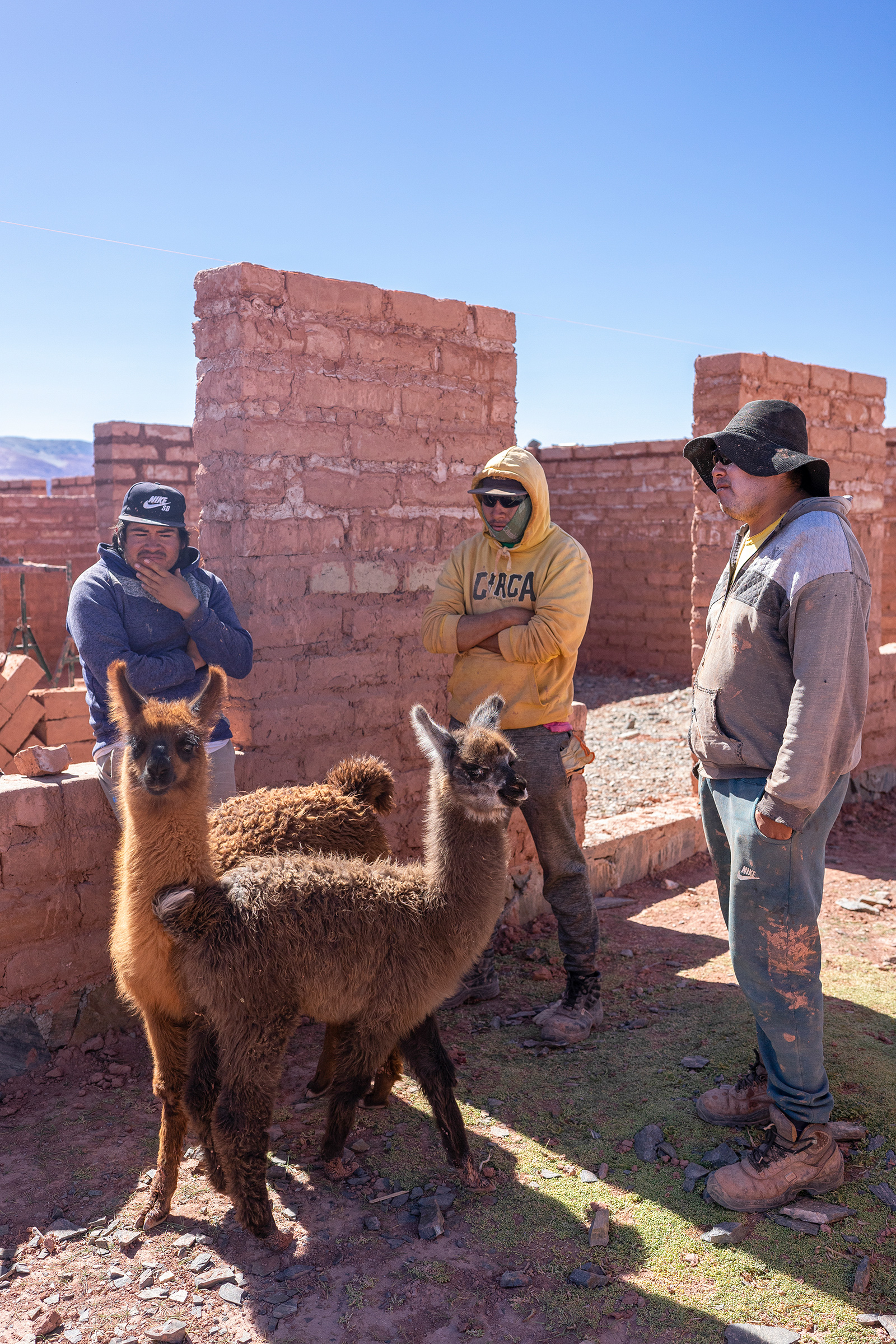
The Vasquez brothers stand beside a half-finished farm house they are building.
Sebastián López Brach for TIME
There’s also a lot on the line for environmental justice. Climate advocates have long been troubled by the fact that obtaining so-called green minerals essential for decarbonization—lithium, cobalt, copper, and more—requires mining processes that often destroy ecosystems and harm communities. In the Democratic Republic of the Congo, dangerous labor conditions in cobalt mines have led human-rights activists to dub the resource “blood cobalt.” In Chile, NGOs call areas damaged by copper and lithium mining “sacrifice zones.” If Kachi works, it could help Argentina’s lithium sector avoid such nicknames. “If we’re going to make an energy transition, we can’t just repeat the sins of the past,” Promnitz says. “We’ve got to do it better.”
Bolivia’s leftist government, which controls the world’s largest lithium deposits but has feared the social and environmental impact of exploiting them, appears to see DLE as the solution. In June, after a pilot scheme examining lithium recovery rates and water use, officials announced that six DLE companies, including Lilac, will be allowed to compete for lithium contracts there.
But amid the scramble for lithium, Argentine environmentalists say that a fairer future is far from secure. Most mining companies aren’t waiting for the rollout of cleaner tech. And projects like Kachi, which promise “cleaner lithium,” have yet to prove they can operate without sapping freshwater resources or altering a little-understood ecosystem. The uncertainty weighs on the Vasquez brothers, who have lived on this land for three generations, and hope to pass it down to their own children one day. “People from outside can come and tell you, ‘Don’t worry nothing will happen,’” Florentín says. “But we’re the ones at risk.”
To spot a lithium mine in South America, look for the evaporation ponds: gigantic, lurid blue-green pools of brine. Such rectangular pools cover dozens of square miles in Chile’s Atacama desert, releasing tens of millions of metric tons of water into the air each year—at least 383.5 metric tons per metric ton of lithium carbonate produced, according to estimates by Argentine researchers. In Catamarca, the pools are currently a rare sight—for now: Argentina, which has struggled for decades with investor-spooking economic dysfunction, has been slow to develop its lithium industry. But at least 14 projects are now in exploration or construction in this province alone.
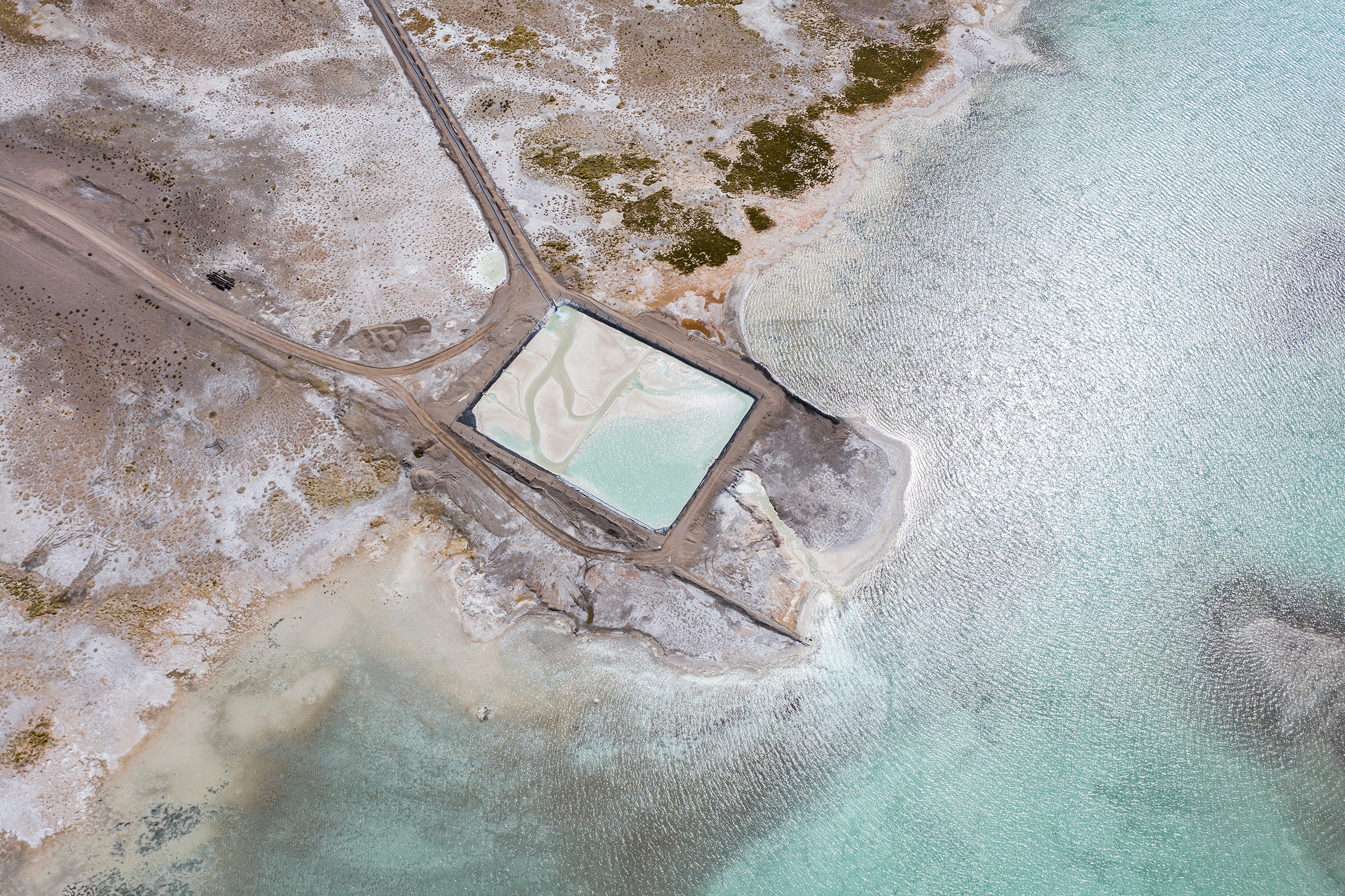
Muerto salt lake, where U.S.-headquartered lithium miner Livent has been operating for 20 years.
Sebastián López Brach for TIME The Hombre
Kachi looks different from these traditional mines. Early on a bright morning in March, the contrasting colors of the site almost sting your eyes: a white salt lake, resembling half-melted snowfall, sits at the foot of a black volcano—all framed by pink and orange mountains and the blue sky. One large red drill bores holes into the lake’s salty crust to extract samples of brine from below.
When construction is complete in two years, there will be more extraction wells, and covered tanks for the ion-exchange process critical to DLE’s efficiency. “We’ll put the brine in those tanks for just three hours,” Promnitz says, squinting at the sun behind his glasses. Inside, lithium atoms will break from the water molecules, and bond instead with tiny ion-exchange beads produced by Lilac Solutions. The beads are then fished out from the brine and washed with a strong acid to separate out lithium chloride. Meanwhile the brine—around 800 metric tons of it per metric ton of lithium carbonate produced—can be returned to the aquifer, Promnitz says. In theory, that should prevent groundwater depletion as reported by communities in Chile. Some freshwater, however, is later used in the process of turning lithium chloride into lithium carbonate, to be shipped to companies that make battery cathodes.
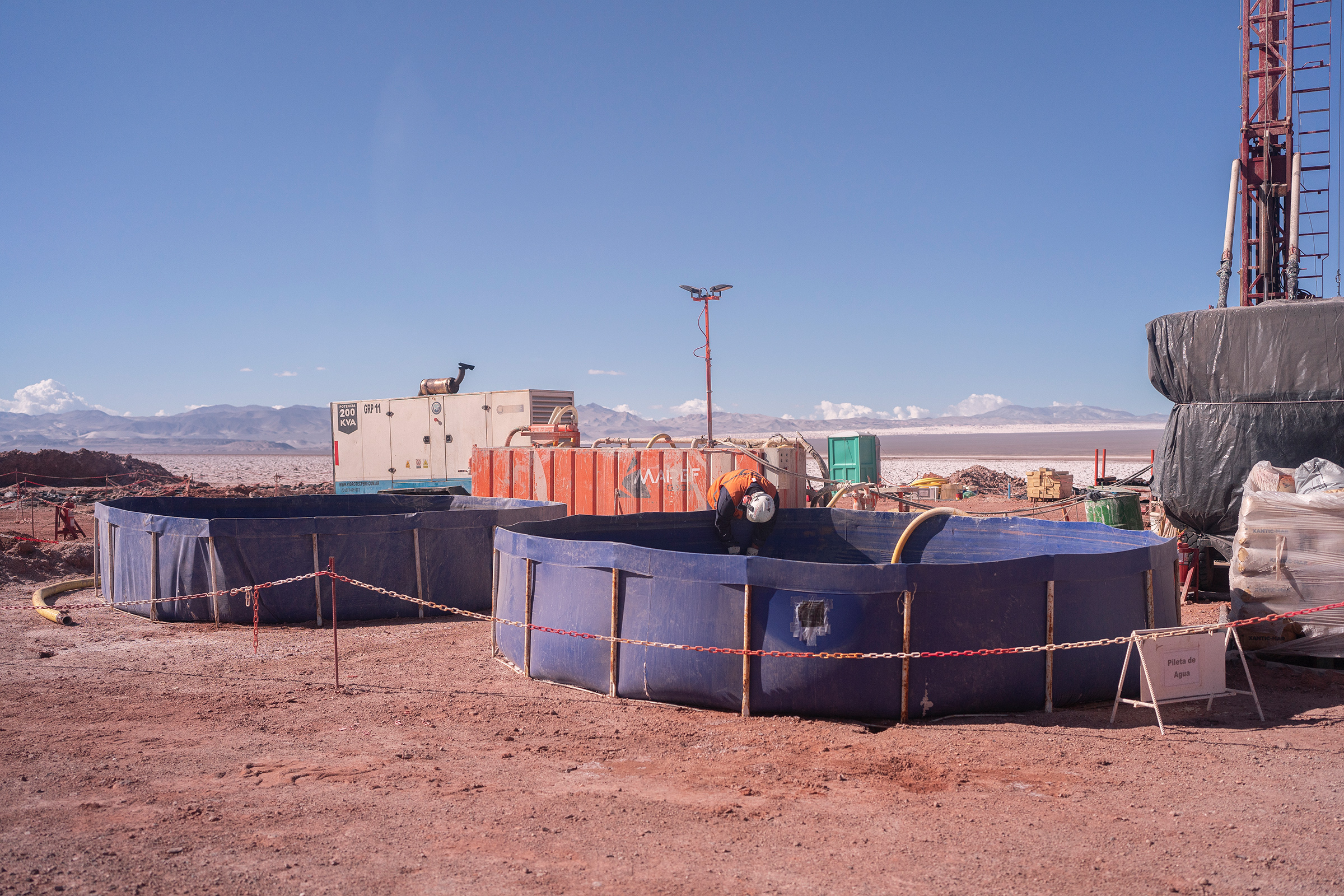
Ponds holding fresh water at the Kachi site.
Sebastián López Brach for TIME
Kachi is the most advanced project for Lilac Solutions, whose investors include BMW, as well as Breakthrough Energy Ventures, an investment fund backed by Bill Gates and Jeff Bezos. Lilac says it has completed a pilot project using the same beads and ion-exchange process somewhere “in the western U.S.” that produced 25 metric tons of lithium carbonate equivalent a year—that’s enough to make batteries for roughly 400 Teslas, according to estimates produced in 2015 by analysts at Goldman Sachs. A slightly larger pilot will be installed this year at Kachi, before commercial-scale production begins in 2024, giving Lilac a chance to prove itself to the global market. In a vote of confidence in April, the Ford Motor Co. signed a nonbinding agreement with Lake Resources to buy 25,000 metric tons of lithium carbonate annually from Kachi. Japanese firm Hanwa has signed a similar memorandum for the other half.
It is likely just a happy coincidence that more efficient—and thus profitable—lithium-extraction methods also have a smaller land and water footprint than traditional approaches. Nevertheless, DLE has attracted green-minded investors, including the U.K. government’s overseas credit agency, which is in talks to provide 70% of the funding for Kachi’s construction. Snydacker says Lilac’s more sustainable technology “can help project developers to avoid the backlash” that some are now seeing from local communities to lithium projects. Chilean mining companies have faced costly legal challenges over their use of brine. In Argentina, anti-mining demonstrations are common in towns in Catamarca and neighboring Jujuy and Salta provinces, generating national headlines about the threats to local water supplies.
Argentine environmentalists are intrigued, but not comforted, by Lake and Lilac’s claims to reduce water use. “They are promising us it will have a lesser impact,” says Patricia Marconi, a Catamarca-based researcher at the YUCHAN Foundation, a regional conservation group. “But they don’t have anything published.” She says Lake has refused to share information with her and her colleagues. The company has not yet released its environmental impact assessment report, fueling uncertainty. (Lake Resources chair Stu Crowe tells TIME the report is still being compiled and is set to be published in the third quarter of 2022.)
Brines extracted from the salt lake at Kachi are held in a well.
Sebastián López Brach for TIME
Eva Vasquez was born in the area where the Kachi project is being developed.
Sebastián López Brach for TIME
Marconi’s concerns center on two issues: First, how will reinjecting massive quantities of brine into the aquifer affect the geological formations below the surface? In a 2018 paper, a group of Argentina-based researchers argued that reinjecting the once lithium-rich brines into the lakes is “a very dangerous oversimplification” of the potential environmental impact of the process. According to the paper, processing the brines to remove lithium could alter their acidity and introduce trace amounts of foreign substances. And companies may have to inject spent brine at different points than where they removed it, essentially to avoid diluting the lithium content where they’re extracting.
The second question is, how much fresh water will be consumed in the final stages of the process? Marconi warns that this water will likely be so-called fossil water—drawn from aquifers confined underground for thousands of years that are not fed fast enough by today’s precipitation to be replenished.
All of this, Marconi says, will have an unknown impact on the little-studied geology and delicate ecosystem of the salt lakes. In their enthusiasm for lithium, she says Argentina’s national and provincial governments are failing to do the research required to anticipate the impacts of a massive mining expansion, turning the country into a “free for all” for the lithium industry. “If we were really taking seriously the idea of not intervening in environmental systems that we don’t understand, there wouldn’t be 20 companies exploring in Catamarca. There would be 20 research teams exploring what’s going to happen,” she says. “Because the harms are irreversible.”
Catamarca has reason to doubt DLE’s environmental promise. Three hours north of Kachi—a teeth-chattering drive over rocky mountain roads—the yellows and greens of the Puna’s summer vegetation are suddenly interrupted by a strange stretch of black ground. This is the valley of the Trapiche River, a water source for the massive Hombre Muerto salt lake. In 1997, Livent, a Philadelphia-based lithium mining company—a key supplier for both Tesla and BMW—built a small dam at the point where the river empties into the salt lake. The dam concentrates the fresh water for use in Livent’s mine, which today can produce up to 20,000 metric tons of lithium each year. On TIME’s visit in March—the last month of the Puna’s wet season—a trickle of water a few feet wide ran past the dam, through a parched, blackened meadow.
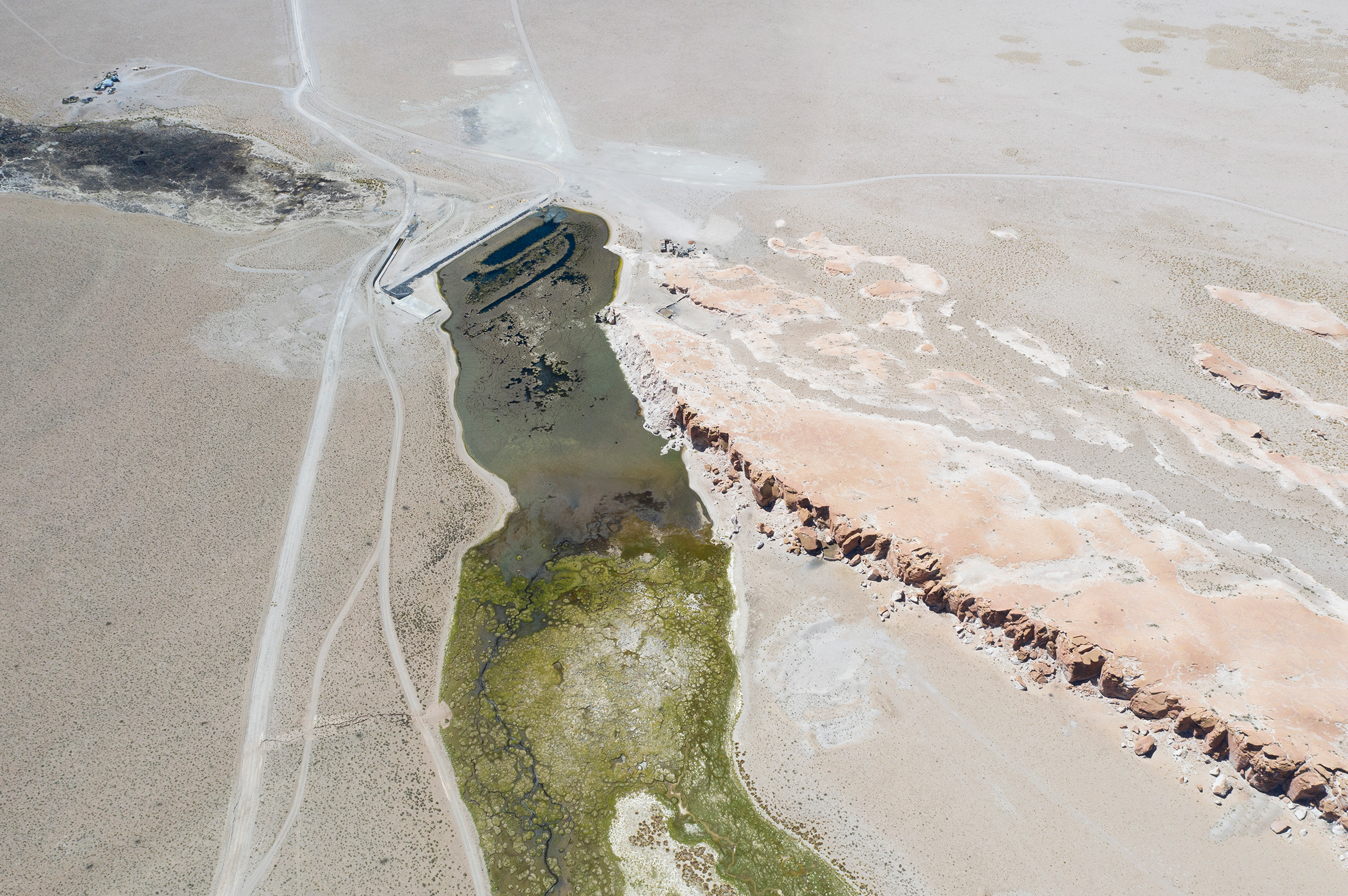
The Trapiche River’s flow is interrupted by a dam built by Livent at the Hombre Muerto salt lake.
Sebastián López Brach for TIME
The project is Argentina’s oldest lithium mine—and it’s also the only one in the western hemisphere to use a form of DLE at scale. Its process is a hybrid: lithium brines are left to evaporate in pools but for “significantly less time,” according to Livent, than in traditional methods, reducing salt water loss. The brine is then passed through a DLE process and afterward, Livent says, “most” of the salt water is returned to “the surrounding Salar habitat.” Later, fresh water from the Trapiche River is used to separate out the lithium. The company would not disclose any numbers on brine use, but claims it has “not contributed to a decrease in brine or water [in the two decades it has operated] at the Salar.”
Román Guitián blames Livent for the valley’s destruction. Guitián grew up next to the river, in a small Indigenous settlement made up of his family and a few others. Before the mining started when he was 17, they used to fetch salt from Hombre Muerto, and raised llamas, goats, and sheep on the valley’s vegetation, says Guitián, standing at the edge of the salt lake next to a beat-up 4×4 that he uses to drive tourists around the mountains. “It was beautiful. But today there are no animals because it’s all dry.”
Signs dotted around the river advertise a program to restore the valley through replanting and new irrigation systems, which Livent launched last year with a regional NGO, the Eco-Conciencia Foundation. And yet, in early March, at an event at Hombre Muerto attended by Argentine officials and Tesla executives, Livent confirmed plans to double the plant’s lithium production capacity by the end of 2023. The company is also planning two further expansions, aiming to bring its total capacity to 100,000 metric tons by 2030. In investor materials, Livent claims that it will incorporate “re-use” and “re-cycling” to limit its fresh water use in the future. But it also says that the later stage of expansion will involve “a more conventional pond evaporation-based process.”
During TIME’s visit, workers were busy digging a pipeline from the Hombre Muerto plant to another river, Los Patos, around 10 miles away. “They destroyed one river and now they’re going to destroy another,” says Guitián. He is currently pursuing legal recognition of an Indigenous community, Atacameños del Altiplano, formed with a few dozen other local people. The designation would give the community a constitutional right to participate in the management of natural resources on their territory. He’d use it to defend the environment from “irresponsible mining” practices, he says. “If the day comes when we don’t have water, we’ll have to emigrate.”

Indigenous activisit Román Guitián stands near the Hombre Muerto salt lake.
Sebastián López Brach for TIME
Catamarca governor Raúl Jalil says the province has learned from the impacts on the Trapiche River. “There are things which maybe went the wrong way in the past, but we are correcting those,” he says. “We are exerting more control now.” Companies are now required to undergo monthly environmental monitoring, and if problems show up, projects will be halted, Jalil says. Livent says it has already installed monitoring stations at both the Trapiche and Los Patos river “to track water levels, recharge rate, and water chemistry to help us use water in a sustainable manner.”
Jalil, however, says he does not plan to restrict the number of lithium projects approved in the province, or ban traditional, water-intensive methods in new mines, unlike Bolivia’s government. “All projects, from agriculture to tourism, have their environmental impact, and we can’t change the whole global energy system without mining,” he says. “The way forward is to reduce the impact more and more, through technology, innovation—at the same time as [continued] extraction.” He wants Kachi to be “a leader case” there.
Promnitz claims Kachi will use water more efficiently than Livent has: Livent’s global fresh water use for 2020—based mainly off of the Hombre Muerto project, its only active lithium carbonate mine—was 72.9 metric tons per metric ton of lithium carbonate equivalent (LCE) produced. In the lab, Lilac says it used 18 metric tons of water per metric ton of LCE. Lake says the rate at Kachi will be significantly below that, and that further water savings will come from plans to use brackish and recycled water.
Promnitz, who began his career as a geologist for mining companies, also claims the brine reinjection process is not as risky as environmentalists fear. The process is similar to one that has been used for decades to enhance oil recovery in the U.S. shale sector, he says, except that the looser sediments of the salt lakes, compared to the tighter formations under oil fields in Texas and Louisiana, should make it less important where the brine is reinjected. “It’s not like [the brine] lives in just one particular formation. We’re just taking the lithium out, and putting back exactly the same brine that was there before.”
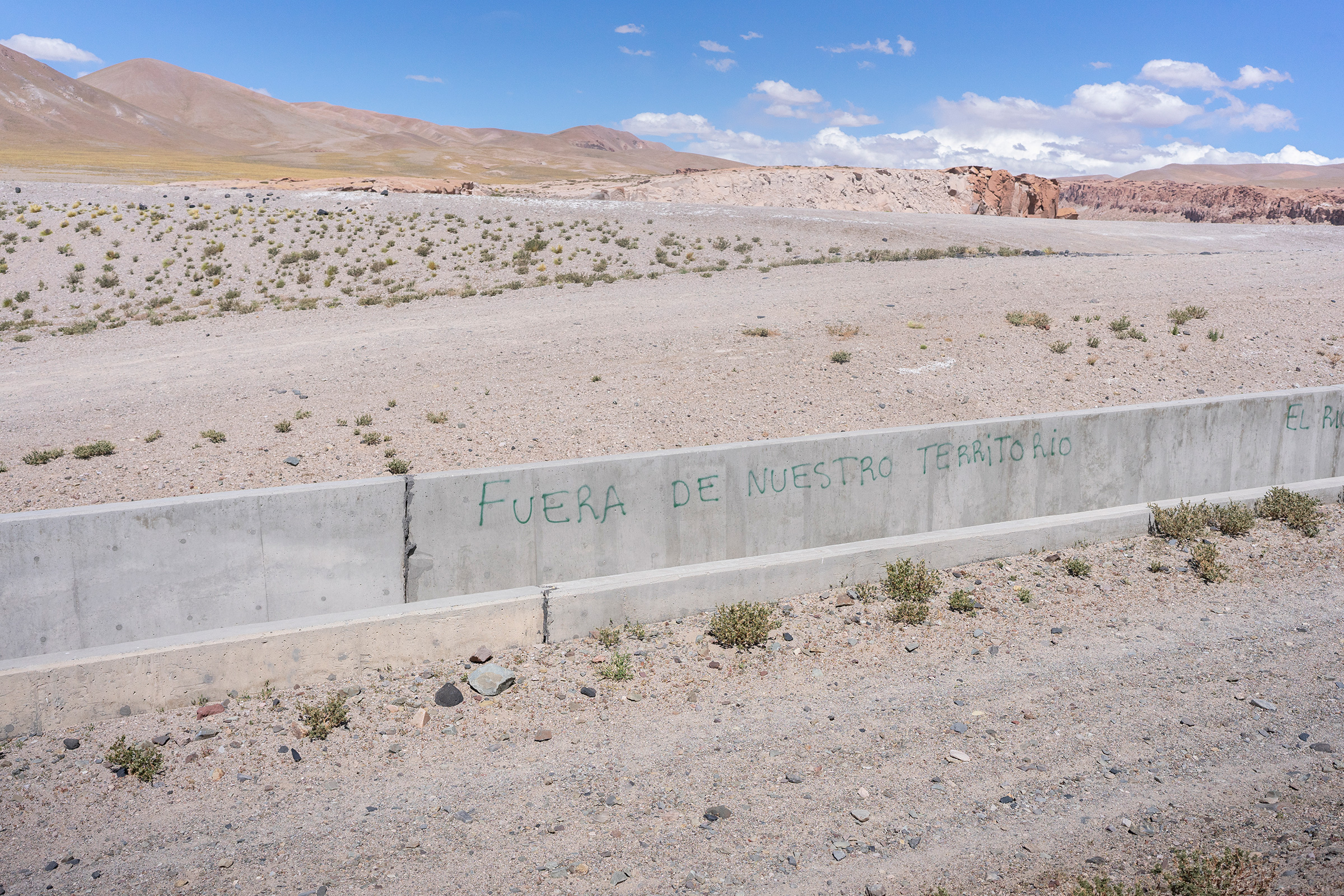
Activists have scrawled ‘Get off our land’ on an aqueduct at Livent’s Hombre Muerto lithium mine.
Sebastián López Brach for TIME
In conversation, Jalil and other local officials in Catamarca appear far more concerned with mining’s economic potential than its environmental risks. Argentina’s northwest has historically been a backwater, receiving little investment from either Buenos Aires or overseas. Politicians see mining as a chance to change that: companies including Livent have paid for roads and bridges on routes that were until recently impassable during bad weather; Lake is in talks to hire local workers and contract services, such as laundries, with local businesses. Though wary of unfulfilled promises, the mayors of both El Peñón and Antofagasta de la Sierra, Kachi’s two closest towns, state versions of the same phrase: “If the company grows, the town should too.”
It’s understandable that local leaders would take that approach, says Juan Carrizo, director of the Eco-Conciencia Foundation, which aims to “resolve socio-environmental conflicts” around mining. “It’s easy to defend the environment from places like Buenos Aires, where you have internet, roads, gas, and transport,” he says. “But here, the development of the community is also on the table.”
A debate over mining plays out on the streets of Antofagasta de la Sierra. Proudly displayed bumper stickers proclaim “I’m a big friend of mining,” while graffiti urges “hands off our land and water.” Florentín, whose farm sits near the Kachi site, is conflicted. He says that if environmental problems did arise from the project, he wouldn’t be sure what to do. “We can try to pressure the company to leave … but I don’t think we want to do that,” he says slowly. “There are a lot of people around here who need work, and they come and tell me that. So I feel kind of cornered.”
We are entering a global mineral mining boom. Carbon-reducing technologies like wind turbines, solar panels, and electric cars require a larger volume and more diverse set of minerals than their dirty counterparts. Already, since 2010, the International Energy Agency says, “the average amount of minerals needed for a new unit of power generation capacity has increased by 50% as the share of renewables has risen.” That gives the global mining industry a chance at a rebrand: from environmental villain to climate savior.
But in an era of increased environmental awareness, communities are also pushing back against mining projects. In January, after weeks of mass protests, the government in Serbia—thought to be home to Europe’s largest lithium deposits—shelved a $2.4 billion project led by mining giant Rio Tinto, which could have provided 90% of Europe’s current lithium needs. Though Rio Tinto is now attempting to reopen talks with the government, which won re-election in April, the episode is a bad omen for plans—such as those being sketched by governments in the U.S. and E.U.—to increase domestic mining of lithium and other “green” minerals.
The risk is that the energy transition strengthens well-worn dynamics in which harmful mining is farmed out to poorer countries where civil society is less able to oppose them. Two months after its Serbia mine was suspended, Rio Tinto completed a $825 million acquisition of a DLE-based lithium project in Salta, Argentina.
Many environmentalists say the fairest way to reduce greenhouse gas emissions would be a more radical transformation of consumption: we would need less lithium if we produced fewer electric cars and instead relied more on public transport and traveled less in the first place.
That vision is unlikely to halt the mining expansion underway in places like Catamarca, though. That leaves communities uncomfortably reliant on companies sticking to their new green promises—and officials holding them to account. If they don’t, the fight against climate change, and the droughts and heatwaves it will bring, will be irrelevant here, Guitián says. “In the future, we’ll have lithium, we’ll have electric cars, but we won’t have water,” he says. “We end up right at the same place.”
Correction, July 26
The original version of this story misstated the organization where Patricia Marconi works as a researcher. It is the YUCHAN Foundation, not the Environmental and Natural Resources Foundation.
More Must-Read Stories From TIME
